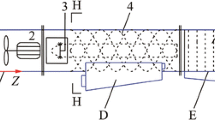The article considers the methods for choosing an economically optimal standard size of a cyclone-dust collector: choosing the optimal type, diameter and number of cyclones. The results of calculating the most profitable options (for given cleaning conditions), as well as economic and energy losses that may occur with an arbitrary choice of the cyclone type and the use of a simplified calculation method used today based on the recommended fixed values of the conventional gas velocity, are presented. Based on the technical and economic calculations, an analysis of the manufactured range of the most common NIIOGAZ cyclones has been performed; a number of missing options for cyclone standard sizes that would reduce the cost of cyclone gas cleaning have been detected.
Similar content being viewed by others
References
A. G. Vetoshkin, Dust Cleaning Processes and Devices: Handbook [in Russian], Izdatel’stvo Penzen. Gos. Univ., Penza (2005).
V. A. Lazarev, Cyclones and Vortex Dust Collectors: Reference Book [in Russian], Firma OZON-NN, Nizhny Novgorod (2006).
A. S. Timonin, Engineering and Environmental Reference Book [in Russian], Vol. 1, Izdatel’stvo N. Bochkarevoi, Kaluga (2003).
A. A. Rusanov (editor), Handbook of Dust and Ash Collection [in Russian], Energiya, Moscow (1975).
V. N. Uzhov (editor), NIIOGAZ Cyclones. Guidelines for Design, Manufacture, Installation and Operation [in Russian], Verkhnevolzhskoe Knizhnoe Izdatel’stvo, Yaroslavl (1970).
Recommendations for the Design of Air Cleaning from Dust in Exhaust Ventilation Systems [in Russian], Stroiizdat, Moscow (1985).
M. I. Rimer (editor), Economic Assessment of Investments: Textbook for Universities [in Russian], Piter, St. Petersburg (2014).
V. G. Lisienko, Ya. M. Shchelokov, and M. G. Ladygichev, Reader of Energy Saving: Reference Book [in Russian], Book 1, Teplotekhnik, Moscow (2005).
Decree of the Government of the Russian Federation of 01/01/2002 “On the Classification of Fixed Assets Included in Depreciation Groups,” No. 1 (2019).
L. Z. Al’pert, Fundamentals of Designing Chemical Installations: Textbook [in Russian], Vysshaya Shkola, Moscow (1989).
I. E. Vorob’ev, “Determining economic efficiency of environmental protection measures in thermal power engineering,” Energet. Elektrif., No. 5, 2–4 (2003).
V. V. Pokotilov, S. A. Makarevich, and V. V. Shirshova, “Methods of feasibility study of energy saving measures,” Arkhit. Stroit., No. 3, 68–71 (2001).
Administrator of the Trading System of the Wholesale Electricity Market JSC, Forecasting the Retail Price for the End Consumer [in Russian]; https://www.atsenergo.ru/sites/default/files/prognoz/28012022_prognoz_roznica_2022_aktualizaciya.pdf.
G. M.-A. Aliev, Technique of Dust Collection and Cleaning of Industrial Gases [in Russian], Metallurgiya, Moscow (1986).
P. A. Kouzov, A. D. Malgin, and G. M. Skryabin, Cleaning Gases and Air from Dust in Chemical Industry [in Russian], Khimiya, St. Petersburg (1993).
V. V. Kuz’min, “Optimization of the conventional gas velocity in a cyclone from the standpoint of economic efficiency and energy saving,” Khim. Neftegaz. Mashinostr., No. 1, 4–7 (2011).
D. I. Misyulya, V. V. Kuz’min, and V. A. Markov, “New design of blade untwisting device of cyclone unit,” Energet. Izv. VUZ. Energet. Ob”edin. SNG, No. 5, 57–60 (2010).
V. V. Kuz’min and D. I. Misyulya, “Economic efficiency of using energy-saving devices in cyclones,” Khim. Neftegaz. Mashinostr., No. 12, 41–43 (2018).
G. Ya Vagin., N. N. Golovkin, E. B. Solntsev, and A. A. Lyamin, “Methods of feasibility study for the introduction of resource and energy saving technologies and equipment in industry,” Promysh. Energet., No. 6, 8–13 (2005).
E. S. Zambrzhitskaya, A. R. Murikova, and E. I. Tikhanova, “Features of determining the discount rate in assessing the economic efficiency and calculating the financial performance of innovative investment projects,” Econom. Upravl. Analiz Tenden. Persp. Razv., No. 3, 83–88 (2013).
Author information
Authors and Affiliations
Corresponding author
Additional information
Translated from Khimicheskoe i Neftegazovoe Mashinostroenie, Vol. 58, No. 9, pp. 44−48, September, 2022
Rights and permissions
Springer Nature or its licensor (e.g. a society or other partner) holds exclusive rights to this article under a publishing agreement with the author(s) or other rightsholder(s); author self-archiving of the accepted manuscript version of this article is solely governed by the terms of such publishing agreement and applicable law.
About this article
Cite this article
Kuzmin, V.V. Selecting the Most Economical Cyclone Standard Size. Chem Petrol Eng 58, 798–805 (2023). https://doi.org/10.1007/s10556-023-01164-x
Published:
Issue Date:
DOI: https://doi.org/10.1007/s10556-023-01164-x




